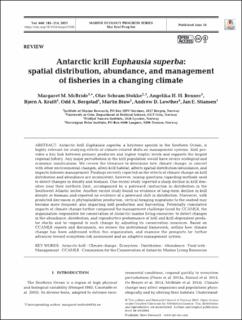| dc.description.abstract | Antarctic krill Euphausia superba, a keystone species in the Southern Ocean, is highly relevant for studying effects of climate-related shifts on management systems. Krill provides a key link between primary producers and higher trophic levels and supports the largest regional fishery. Any major perturbation in the krill population would have severe ecological and economic ramifications. We review the literature to determine how climate change, in concert with other environmental changes, alters krill habitat, affects spatial distribution/abundance, and impacts fisheries management. Findings recently reported on the effects of climate change on krill distribution and abundance are inconsistent, however, raising questions regarding methods used to detect changes in density and biomass. One recent study reported a sharp decline in krill densities near their northern limit, accompanied by a poleward contraction in distribution in the Southwest Atlantic sector. Another recent study found no evidence of long-term decline in krill density or biomass and reported no evidence of a poleward shift in distribution. Moreover, with predicted decreases in phytoplankton production, vertical foraging migrations to the seabed may become more frequent, also impacting krill production and harvesting. Potentially cumulative impacts of climate change further compound the management challenge faced by CCAMLR, the organization responsible for conservation of Antarctic marine living resources: to detect changes in the abundance, distribution, and reproductive performance of krill and krill-dependent predator stocks and to respond to such change by adjusting its conservation measures. Based on CCAMLR reports and documents, we review the institutional framework, outline how climate change has been addressed within this organization, and examine the prospects for further advances toward ecosystem risk assessment and an adaptive management system. | |
